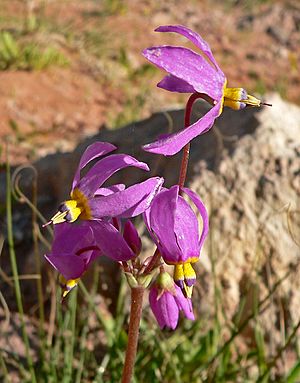Pretty shooting star facts for kids
Quick facts for kids Pretty shooting star |
|
|---|---|
 |
|
| Scientific classification | |
| Genus: |
Primula
|
| Species: |
pauciflora
|
| Synonyms | |
|
According to Plants of the World Online:
According to the Jepson eFlora:
|
|
The pretty shooting star (scientific name: Primula pauciflora) is a beautiful flowering plant that belongs to the primula family. It's also known by other names like the few-flowered shooting star or prairie shooting star. This plant grows across a huge area in western North America, from very cold northern regions all the way down to Mexico. You can often find it in dry places like the Great Basin Desert and the Mojave Desert. Sometimes, this plant is also called Dodecatheon pauciflorum or Dodecatheon pulchellum.
Contents
About the Pretty Shooting Star Plant
The pretty shooting star is a very diverse plant. This means it can look quite different depending on where it grows. Generally, the plant has no hairs and its flower stem grows about 10 to 40 centimeters (4 to 16 inches) tall.
Each plant has a cluster of 2 to 15 flowers at the top of its stem. The petals of these flowers are usually 9 to 14 millimeters (about 0.35 to 0.55 inches) long. They can be magenta (a bright purplish-pink) or lavender in color.
One common type, Primula pauciflora var. pauciflora, is a herbaceous perennial. This means it's a non-woody plant that lives for more than two years. It grows from short roots and does not have small bulbs. This variety can grow between 5 and 40 centimeters (2 to 16 inches) tall.
Leaves and Flowers
The leaves of the pretty shooting star grow from the base of the plant. They are usually 2 to 15 centimeters (0.8 to 6 inches) long. Their shape can be oblong or lance-shaped, and they are mostly smooth or have small teeth. The leaves gradually narrow into winged stalks.
The green outer parts of the flower, called the calyx, often have purple spots. The five parts of the calyx are 3 to 5 millimeters long. The colorful part of the flower, called the corolla, is 10 to 20 millimeters long. Its five petals sweep backwards and are usually purplish-lavender. Sometimes, they can be white. The short tube at the base of the petals is yellowish, often with a wavy purple line.
The five anthers, which hold the pollen, are joined together. They are usually yellowish to reddish-purple and 4 to 7 millimeters long. The plant flowers between April and August. After flowering, it produces capsules, which are like small seed pods. These capsules are 5 to 15 millimeters long and open from the tip to release many seeds.
Types of Pretty Shooting Star Plants
As of April 2022, there are seven main types, or varieties, of Primula pauciflora. Each variety grows in different parts of North America:
- Primula pauciflora var. cusickii – Found in British Columbia, Idaho, Montana, Oregon, Washington State, and Wyoming.
- Primula pauciflora var. distola – Found in South Dakota and Wyoming.
- Primula pauciflora var. macrocarpa – Found in Alaska, British Columbia, California, Oregon, and Washington State.
- Primula pauciflora var. monantha – Found in California, Oregon, Utah, and Washington State.
- Primula pauciflora var. pauciflora – This type is widespread, growing from cold northern regions all the way to Mexico.
- Primula pauciflora var. shoshonensis – Found in California, Idaho, Nevada, Oregon, and Utah.
- Primula pauciflora var. zionensis – Found in Arizona, Colorado, and Utah.
Growing the Pretty Shooting Star
The pretty shooting star, sometimes known as Dodecatheon pulchellum in gardens, is a popular plant for cultivation. It has even won an Award of Garden Merit from the Royal Horticultural Society, which means it's a great plant for gardens!
This plant can survive in cold temperatures, down to about -15 degrees Celsius (5 degrees Fahrenheit). However, it grows best in a protected spot that gets some shade or full shade. It prefers soil that is neutral or slightly acidic, similar to what you might find in a woodland area.
Traditional Uses by Native Americans
The pretty shooting star was important to some Native American groups. The Okanagan-Colville people and the Blackfoot Indians used it for different purposes.
They would make a special liquid by soaking the plant's roots in water. This liquid was then used as a wash for sore eyes. A cooled version of this liquid, made from the leaves, was also used as eye drops. Sometimes, an infusion (a liquid made by steeping leaves) from the leaves was used as a gargle, especially by children, to help with mouth sores.

